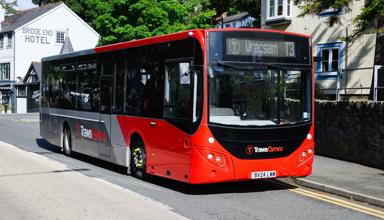Article by Andrew Minnis, National Assembly for Wales Research Service
 The Welsh Government’s plans for an M4 relief road south of Newport, between junctions 23 and 29 of the current M4, took another step forward on 10 March. A substantial number of documents marking a key stage in the planning and delivery process were published. Ten public exhibitions were also announced where members of the public can inspect draft orders, environmental information and other associated reports and materials. This blog post explains what has been published and what happens next.
The Welsh Government’s plans for an M4 relief road south of Newport, between junctions 23 and 29 of the current M4, took another step forward on 10 March. A substantial number of documents marking a key stage in the planning and delivery process were published. Ten public exhibitions were also announced where members of the public can inspect draft orders, environmental information and other associated reports and materials. This blog post explains what has been published and what happens next.
What’s been published?
A pretty substantial number of documents has been published in three areas. Draft Orders and Statutory Certificates Four draft orders have been published using powers conferred under the Highways Act 1980:
- A draft scheme order providing the power to build the road and other slip/connecting roads along with new bridges;
- A draft scheme variation order permitting reclassification of sections of the existing M4 and A48M as ‘A’ roads;
- A draft line order providing powers to construct new stretches of trunk road; and
- A draft side roads order: to authorise changes to local highways and private access.
Two more documents are expected to be published on 24 March 2016:
- A draft compulsory purchase order: providing powers to acquire the land needed to build the road; and
- Section 19 certificates: under s19 of the Acquisition of Land Act 1981 giving powers to replace common land and allotments.
Environmental Statement
The Environmental Statement sets out the Welsh Government’s assessment of the main environmental effects it has identified during development work. It describes how the Welsh Government intends to mitigate the impact of the road. The statement itself is a huge document. However, the Environmental Statement – Non Technical Summary gives a more digestible version of the findings. In particular, it summarises environmental specialist assessments considering impact and mitigation in areas such as:
- road drainage and flooding;
- air quality;
- cultural heritage;
- landscape and visual impact;
- ecology and nature conservation;
- geology and soils;
- noise and vibration; and
- impact on community and private assets.
“Associated Reports”
A range of other “associated reports” have also been made available, including a scheme assessment report, a sustainable development report, an economic assessment reports and a traffic forecasting report. The scheme assessment report gives a useful overview of what is happening. It summarises key non-environmental aspects of the scheme including details of the route, walking and cycling infrastructure, the junctions, bridges and other structures required, and how far the scheme affects connectivity from side roads. Thirty five bridges are planned, including a River Usk / Newport Docks crossing, presumably to try to address concerns from Associated British Ports that the new road will negatively affect the operation of the Port of Newport. The report also says that the scheme would require a total of approximately 721 hectares of land, including land needed temporarily for construction. This is said to include “areas of environmental and historical interest”. The road will require demolition of 12 residential buildings, 5 of which are already Welsh Government owned, including one Grade II listed building. The assessment also sets out what the Welsh Government expects the impact on congestion to be: Total vehicle transfer from the existing M4 around Newport is generally anticipated to be 45-48% (rising to 60% through the tunnel because there is less local movement through the tunnel). The level of HGV traffic transfer at the tunnel is expected to be about 75%.
Do we know more now about the cost?
Yes. The documentation includes cost estimates. While the First Minister told the Assembly on 12th May 2015 that the relief road would cost “well below £1billion”, these documents suggest the total cost will be higher. While the estimated construction cost set out in the assessment is £857m, the “project estimate” included in the scheme assessment report (i.e. including “work by others”, land and compensation and project risk/optimism bias) comes to £1.093 billion. It is worth noting that these figures are the “project estimate, excluding VAT and inflation”. Additionally, the economic appraisal report identifies further costs of about £38.19m, including costs of £16.19m for reclassification and reconfiguration of Caerleon Junction which are outside the scope of the main contract, so that the “total cost for economic appraisal” is estimated at £1.131 billion. The assessment makes clear that the project would be funded “through a combination of UK Government borrowing and Welsh Government Transport budgets”. It anticipates that three quarters of the project costs will be spent in the Welsh supply chain, and estimates the benefit-cost-ratio to be 2.83 (i.e. a return of £2.83 for every £1 spent).
Where do we go from here?
The public is invited to respond to Welsh Government on the draft orders and environmental statement by 4 May 2016. Depending on these responses, the Welsh Ministers will decide whether to hold a Public Local Enquiry. If they do, the Welsh Government anticipates this taking place in autumn/winter 2017 and then, following the inspector’s report, the Welsh Ministers will decide whether to proceed with the scheme. If they do decide to go ahead, and barring any further legal challenge, construction is expected to start in spring 2018, with opening planned for autumn 2021. At this point work to reclassify the existing M4 route as a trunk road would begin to be completed in Autumn 2022.






